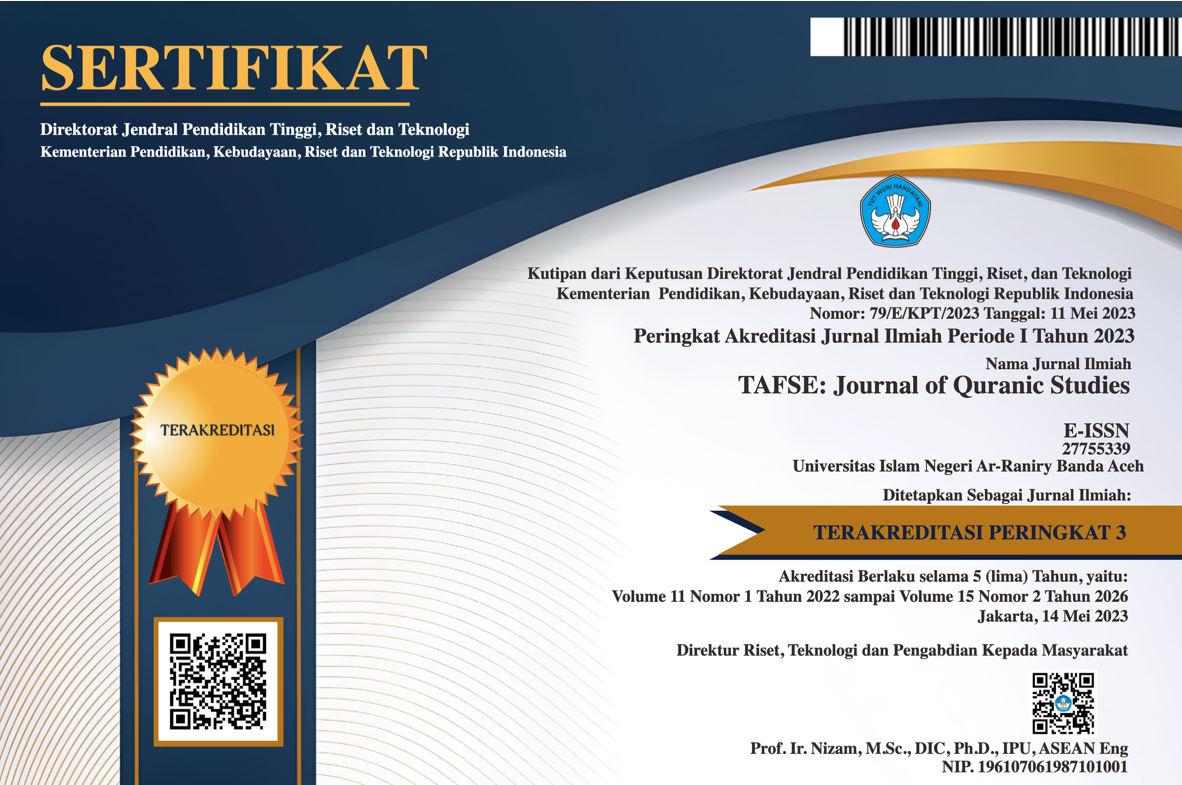Penggunaan Lafaz Bahjah, Jamal dan Zukhruf dalam Al-Qur’an
DOI:
https://doi.org/10.22373/tafse.v5i1.12521Keywords:
Muradif, Bahjah, Jamal, ZukhrufAbstract
The choice of vocabulary in the Qur'an is not a coincidence, but each word has its own value of balaghah. The beauty of the language and style of the Qur'an can be seen from its balaghah and fasahah, both concretely and abstractly. The Qur'an sometimes uses several words that have the same or close meanings, so there seems to be an inconsistency in the words it uses. This study will examine the use of the words bahjah, jamᾱl and zukhruf which means beautiful in the Qur'an. This research is library research using the maudhu'i method. The main sources of data are the verses of the Qur'an that contain the words bahjah, jamᾱl and zukhruf as well as secondary sources in the form of books of tafsir, mu'jam and other related scientific sources. In the Qur'an, the words bahjah, jamᾱl and zukhruf have meanings that are almost related to each other but with different contexts and purposes. Bahjah is defined by the beautiful colors used to express the beauty in the trees, flowers, mountains, oceans, etc. that make the earth look beautiful. Jamᾱl in the Qur'an is generally used to describe the beauty that radiates from a nature that will not be mentioned unless there is dispute or friction. As for zukhruf, it is used in the Qur'an to mention concrete decoration, but if it is paired with other words, then the decoration in question is abstract decoration.
Pemilihan kosa kata dalam Alquran, bukanlah suatu kebetulan tetapi setiap kata mempunyai nilai balaghah tersendiri. Keindahan bahasa dan uslub Alquran yang menakjubkan terlihat dari balaghah dan fasahahnya, baik yang konkrit maupun abstrak. Alquran kadangkala menggunakan beberapa kata yang memiliki arti sama atau dekat, sehingga tampak adanya inkonsistensi dalam kata-kata yang digunakannya. Kajian ini akan mengkaji penggunaan lafaz bahjah, jamᾱl dan zukhruf yang bermakna indah dalam Alquran. Penelitian ini berupa riset kepustakaan (library research) dengan menggunakan metode maudhu’i. Sumber data utama yaitu ayat-ayat Alquran yang mengandung lafaz bahjah, jamᾱl dan zukhruf serta sumber sekunder berupa kitab-kitab tafsir, mu’jam dan sumber ilmiah terkait lainnya. Dalam Alquran lafaz bahjah, jamᾱl dan zukhruf mempunyai makna yang hampir berkaitan antara satu dengan lainnya namun dengan konteks dan tujuan yang berbeda. Bahjah diartikan dengan warna yang indah yang digunakan untuk menyebutkan keindahan pada pepohonan, bunga-bungaan, pegunungan, lautan, dan lain-lain yang menjadikan bumi terlihat indah. Jamᾱl dalam Alquran pada umumnya digunakan untuk menyebutkan keindahan yang terpancar dari sesuatu sifat yang tidak akan disebutkan kecuali terjadi perselisihan atau gesekan. Adapun zukhruf digunakan dalam Alquran untuk menyebutkan hiasan yang konkrit akan tetapi jika disandingkan dengan kata lain maka hiasan yang dimaksud adalah hiasan yang abstrak.
Downloads
References
Abu al-Husain ‘Ali bin Ismail. Al-Muhkam Wa Al-Mulut Al-‘Azam, Juz 5. 1st ed. Beirut: Dar al-Kutub al-‘Ilmiyah, 2000.
Abu Mazfar Mansur bin Muhammad bin ‘Abd al-Jabbar bin Ahmad al-Maruzi al-Sam’ani. Tafsir Al-Qur’an, Juz 2. 1st ed. Dar al-Wathan, 1997.
Ahmad Musthafa al-Maraghi. Tafsir Al-Maraghi,Terj. Bahrun Abu Bakar dkk, Jilid 28. Semarang: Karya Toha Putra, 1993.
Ahmad Warson Munawwir. Al-Munawwir, Kamus Arab-Indonesia. Surabaya: Pustaka Progressif, 1997.
Al-Baghwi, Abu Muhammad al-Husain bin Mas’ud. Ma’allim Al-Tanzil Fi Tafsir Al-Quran, Juz 3,. 4th ed. Dar Tayyibah li al-Nasyr wa al-Tauzi, 1997.
Ar-Raghib Al-Asfahani. Al-Mufradat Fi Gharibil Al-Qur’an, Terj. Ahmad Zaini Dahlan. Jawa Barat: Khazanah Fawaid, 2017.
Atabik Ali dan Ahmad Muhdlor. Kamus Kontomporer Arab-Indonesia. 9th ed. Yogyakarta: Multi Karya Grafika, n.d.
Departemen Agama RI. Al-Qur’an Dan Tafsirnya, Jilid 7. Jakarta: Ikrar Mandiri Abadi, 2010.
Habib Nasir dan Afif Muhammad. Ensiklopedia Ekonomi Dan Perbankan Syaria’h. 1st ed. Bandung: Kaki Langit, 2004.
Hamka. Tafsir Al-Azhar, Vol. 5. Singapura: Pustaka Nasional, 2003.
Ibn Taimiyah al-Harrani dan Ibn Qayyim al-Jauziyah. Cantik Luar Dalam, Terj. Ahmad Saikhu. Serambi Ilmu Semesta, 2008.
M. Quraish Shihab. Tafsir Al-Mishbah, Vol. 9. Jakarta: Lentera Hati, 2002.
Majduddin al-Firuzzabadi. Al-Qamus Al-Muhit, n.d.
Muhammad bin Ahmad bin al-Azhari Abu Mansur. Tahzib Al-Lughah. 1st ed. Beirut: Dar Ihya al-Turas al-Farabi, 2001.
Muhammad bin Mukrim bin ‘ali ibn Munzir. Lisan Al-’Arab, Juz 2. 3rd ed. Beirut: Dar Sadir, n.d.
Muhammad Fuad ‘Abd al-Baqi. Mu’jam Al-Mufahras Li Alfaz Alquran Al-Karim. Dar al-Hadts, 2008.
Syahrur, Muhammad. Al-Kitab Wa Alquran: Qira’ah Muashirah. Damaskus: Al-Ahafi li al-Tiba’ah wa al- Nashr wa al-Tawzi, 1991.
Wahbah al-Zuhaili. Tafsir Al-Munir: Aqidah, Syari’ah, Manhaj, Terj. Abdul Hayyi Al-Kattani, Jilid 7. Jakarta: Gema Insani, 2016.
Wahbah al-Zuhaili. Tafsir Al Wasith, Terj Muhtadi dkk, Vol. 2. Depok: Gema Insani, 2013.
Yusuf al-Qardawi. Fiqh Al-Zakat, Jilid 1. Beirut: Ar-Risalah, 1973.
Downloads
Published
Issue
Section
License
Authors who publish with this journal agree to the following terms:
- Authors retain copyright and grant the journal right of first publication with the work simultaneously licensed under a Creative Commons Attribution License (CC BY NC 4.0) that allows others to share the work with an acknowledgment of the work's authorship and initial publication in this journal.
- Authors are able to enter into separate, additional contractual arrangements for the non-exclusive distribution of the journal's published version of the work (e.g., post it to an institutional repository or publish it in a book), with an acknowledgment of its initial publication in this journal.
- Authors are permitted and encouraged to post their work online (e.g., in institutional repositories or on their website) prior to and during the submission process, as it can lead to productive exchanges, as well as earlier and greater citation of published work (See The Effect of Open Access).





